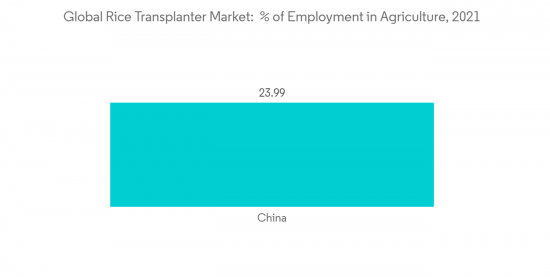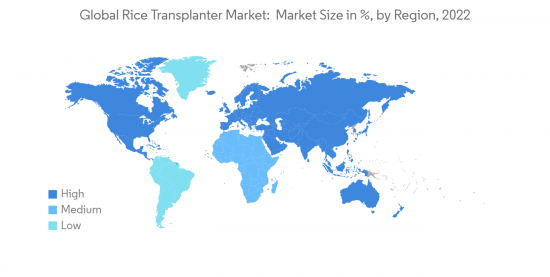
|
市場調査レポート
商品コード
1331363
田植機の世界市場規模・シェア分析-成長動向と予測(2023年~2028年)Global Rice Transplanter Market Size & Share Analysis - Growth Trends & Forecasts (2023 - 2028) |
||||||
カスタマイズ可能
適宜更新あり
|
|||||||
| 田植機の世界市場規模・シェア分析-成長動向と予測(2023年~2028年) |
|
出版日: 2023年08月08日
発行: Mordor Intelligence
ページ情報: 英文 70 Pages
納期: 2~3営業日
|
- 全表示
- 概要
- 目次
田植機の世界市場規模は2023年に14億8,000万米ドルと推定され、2028年には19億6,000万米ドルに達すると予測され、予測期間中(2023-2028年)にCAGR 5.80%で成長する見込みです。
主なハイライト
- 世界の人口増加により食糧需要が高まっており、特にアジアなどの地域では田植機などの農業機械の需要が高まっています。そのため、農業労働者は都市部にシフトしています。世界の農業労働力の減少が、農場主が田植機のような農業機械を選ぶ主な理由です。国際労働機関(ILO)のデータによると、世界中で農業に従事する人の割合は、2022年には26%に減少します。
- 自走式の田植機を使用することで、農家は手作業による田植えよりも経済的なメリットが得られるためです。機械移植は、手作業に比べ、穀物収量を大幅に増加させ、労力と時間を削減しています。インド食料農業評議会(ICFA)によると、インドにおける農業従事者の割合は、2050年には25.7%減少すると推定されています。
- アジア太平洋は、調査対象市場の最大の地域セグメントであり、総シェアの半分以上を占めています。水田での労働力不足作業の増加や継続的な技術革新などの促進要因が、インドや中国などの主要米生産国における田植え機の効率向上に役立っています。
田植機の市場動向
農作業の減少が市場を牽引
- 新興経済諸国では、農業に依存する人口の割合が大きくなっており、年々多くの人々が都市部に移住しているため、時間の経過とともに減少しています。国連食糧農業機関(FAO)によると、中国のような国々では2021年に農業部門の雇用が23.9%激減し、前年比24.4%減となっています。これは主に、先進国の近代農業の名の下に支配されている農業機械によるものです。貧しい国では人口の3分の2以上が農業に従事しているが、豊かな国では5%にも満たないです。そのため、農業機械メーカーは新製品を市場に投入する機会を得ており、将来の市場成長を後押ししています。
- 国際労働機関(ILO)のデータによると、世界中で農業に従事する人の割合は、2022年には26%まで低下します。米国を含む多くの先進諸国では、農業従事者の平均年齢は60歳です。それでも、農村部の若者が都会での生活を求めて国を飛び出したため、平均年齢は上昇しています。このことは、予測期間中に機械市場が新興国で成長することを後押ししています。
- Indian Council of Food and Agricultureによると、インドでは農業従事者の割合が2050年には25.7%減少すると推定されており、これが同国での農業機械需要の増加につながっています。したがって、田植機市場の需要は予測期間中に増加すると思われます。

アジア太平洋が市場を独占
- 米は中国やインドのような多くのアジア諸国の主食作物であり、世界の米のほぼ90%はアジア太平洋地域で栽培されています。アジア諸国では人口が増加しており、特にこの地域で最も人口の多いインドのような国々では食糧需要が高まっています。
- World Population Review(WPR)によると、インドの人口は2022年には141.7億人だったが、2025年には14億1,000万人にしかならないと予想されています。このような人口の増加により、この地域の食糧需要は増加しています。米は100カ国以上で主食となっており、特にアジアでは飢餓をなくすためには米の生産拡大が不可欠です。
- インドの小規模農家は通常、手作業で田植えを行っています。手作業による田植えには、1ヘクタールあたり約238時間の労働時間が必要でした。さまざまな稲の定着方法のパフォーマンスを評価した結果、機械移植機に続く稲集約法のシステムで、最大の穀物生産性が確認されました。農作業に必要な労働力が減少したことで、インドでは機械式移植機の利用率が高まっています。
- 中国は世界最大のコメ生産国で、世界のコメ生産量の30%を占めており、手作業や機械式など様々な方法を導入しています。手作業による移植は、熟練労働者の不足により農村部では減少しています。人口が多く、利用可能な労働力の割合が高いため、土地が狭いこれらの地域では一般的です。中国は他のアジア諸国に水稲を輸出しているため、この地域では大きなシェアを占めています。中国のほぼすべての省で稲作が行われており、年間生産量は世界の米の4分の1を超えます。インドの農家は手動式の機械を好むが、中国やアジア諸国では乗用タイプの田植機の需要が高いです。

田植機産業の概要
田植機市場は細分化されており、様々な中小企業が厳しい競合を招いています。世界各地で地域市場やローカルプレーヤーが開拓されていることが、市場が断片化している主な要因です。クボタのような主要企業は、その研究開発チームと技術によって、スマートなソリューションを提供することができます。各プレイヤーは、市場で競争するためにスマートかつ革新的な方法で取り組んでいます。クボタ、ヰセキ、三菱、CLASS、CNH Industrialの5社が、この市場で競争している主要企業です。
その他の特典
- エクセル形式の市場予測(ME)シート
- 3ヶ月間のアナリストサポート
目次
第1章 イントロダクション
- 調査の前提と市場定義
- 調査範囲
第2章 調査手法
第3章 エグゼクティブサマリー
第4章 市場力学
- 市場概要
- 市場促進要因
- 市場抑制要因
- ポーターのファイブフォース分析
- 供給企業の交渉力
- 買い手・消費者の交渉力
- 新規参入業者の脅威
- 代替品の脅威
- 競争企業間の敵対関係の強さ
第5章 市場セグメンテーション
- 製品タイプ
- 乗用田植機
- 歩行型田植機
- 地域
- 北米
- 米国
- カナダ
- メキシコ
- その他北米地域
- 欧州
- ドイツ
- 英国
- フランス
- イタリア
- スペイン
- ロシア
- その他欧州
- アジア太平洋
- 中国
- 日本
- インド
- オーストラリア
- その他アジア太平洋地域
- 南米
- ブラジル
- アルゼンチン
- その他南米
- アフリカ
- 南アフリカ
- その他中東とアフリカ
- 北米
第6章 競合情勢
- 最も活発な企業
- 最も採用されている戦略
- 市場シェア分析
- 企業プロファイル
- Kubota Carporation
- CNH Industrial
- CLAAS KGaA mbH
- Iseki & Co., Ltd.
- Mitsubishi
- Yanmar Co., Ltd
- Mahindra & Mahindra Limited
- TYM Corporation
- Jiangsu World Agriculture Machinery Co., Ltd
- LEMKEN GmbH & Co. KG
- Shandong Fuerwo Agricultural Equipment Co., Ltd
第7章 市場機会と今後の動向
The Global Rice Transplanter Market size is estimated at USD 1.48 billion in 2023, and is expected to reach USD 1.96 billion by 2028, growing at a CAGR of 5.80% during the forecast period (2023-2028).
Key Highlights
- The rise in population across the globe is inducing a high demand for food, which in turn is driving the demand for farming machinery such as rice transplanters, especially in regions like Asia. Therefore, agricultural laborers are shifting to urban areas. The global decline in farm labor is the major reason that farm owners opt for agricultural machinery like rice transplanters. According to data from the International Labor Organization (ILO), worldwide, the percentage of people who work in agriculture dropped to 26% in 2022.
- Reducing manpower availability for agricultural work has increased mechanical transplanters' availability because using a self-propelled transplanter gives economic benefits to the farmers over manual transplanting methods. Mechanical transplanting has significantly increased grain yield and decreased drudgery and time compared to manual operations. According to the Indian Council of Food and Agriculture (ICFA), the percentage of agriculture workers in India is estimated to decline by 25.7% in 2050.
- Asia-Pacific is the largest geographical segment of the market studied and accounts for more than half of the total share. Some of the driving factors, like increasing labor shortage work in the paddy fields and continuous technological innovations, have helped increase the efficiency of rice machinery in major rice-producing countries like India and China.
Rice Transplanter Market Trends
Decline in Farm Labor is Driving the Market
- Developing economies have larger percentages of the population dependent on agriculture, decreasing over time as many people have migrated to the urban area every year. According to Food and Agriculture Organization (FAO), employment in the agriculture sector declined drastically in countries like China in 2021 by 23.9% compared to the previous year, with 24.4%. This is primarily due to agricultural machinery ruling under the name of modern agriculture in developed countries. While more than two-thirds of the population in poor countries work in agriculture, less than 5% of the population does in rich countries. This is making opportunity for the players to produce new products in the market, hence boosting the market's growth in future years.
- According to data from the International Labor Organization, worldwide, the percentage of people who work in agriculture will have dropped to 26% in 2022. In many developed countries, including the United States, the average age of a farmer is 60. Still, the average age is rising as the rural youth has branched out from their countries to seek a life in the city. This pushes the machinery market to grow in developed countries during the forecast period.
- According to the Indian Council of Food and Agriculture, the percentage of agriculture workers in India is estimated to decline by 25.7% in 2050, which has led to increasing demand for agricultural equipment in the country. Hence, the rice transplanter market demand will increase during the forecast period.

Asia-Pacific Dominates the Market
- Rice is the staple crop for many Asian countries like China and India, with almost 90% of the world's rice grown in the Asia Pacific. The growing population in Asian countries is raising the demand for food, especially in countries like India which is the most populated country in the region.
- According to the World Population Review (WPR), India's population was 141.7 cr in 2022, and it is expected to only have a population of 1.41 billion by 2025. This increase in population has increased the demand for food in the region. Rice is the main staple food in more than 100 countries, and enhancement in rice production is crucial to ending hunger, especially in Asia.
- Small farmers in India usually perform rice transplanting manually. Manual paddy transplanting required about 238 man hours per hectare. The performance of different rice establishment methods was evaluated, and the maximum grain productivity was found under the system of rice intensification method followed by mechanical transplanter. Reducing manpower availability for agricultural work has increased the availability of mechanical transplanters in India.
- China is the world's largest producer of rice, making up 30% of global rice production, which deploys various methods like manual or mechanical. Manual transplanting is declining in rural areas due to a lack of skilled labor. It is common in these areas with smaller land due to high populations and higher rates of available labor. China dominates the market in this region with a major market share as it exports paddy to other Asian countries. Nearly every province in China plants rice and produces more than one-fourth of the world's rice annually. Farmers in India prefer manually operated machines, while China and countries in Asia witness a higher demand for riding type of rice transplanter machines.

Rice Transplanter Industry Overview
The rice transplanter market is fragmented, with various small and medium-sized companies resulting in stiff competition. The development of regional markets and local players in different parts of the world is the major factor for the fragmented nature of the market. Major Player like Kubota Inc, with their R&D team and technology, is able to provide a smart solution. Every player is working smartly and in an innovative way to compete in the market. Kubota, Iseki, Mitsubishi, CLASS, and CNH Industrial are the five major players competing in the market.
Additional Benefits:
- The market estimate (ME) sheet in Excel format
- 3 months of analyst support
TABLE OF CONTENTS
1 INTRODUCTION
- 1.1 Study Assumptions and Market Definition
- 1.2 Scope of the Study
2 RESEARCH METHODOLOGY
3 EXECUTIVE SUMMARY
4 MARKET DYNAMICS
- 4.1 Market Overview
- 4.2 Market Drivers
- 4.3 Market Restraints
- 4.4 Porter's Five Forces Analysis
- 4.4.1 Bargaining Power of Suppliers
- 4.4.2 Bargaining Power of Buyers/Consumers
- 4.4.3 Threat of New Entrants
- 4.4.4 Threat of Substitute Products
- 4.4.5 Intensity of Competitive Rivalry
5 MARKET SEGMENTATION
- 5.1 Product Type
- 5.1.1 Ride-on Rice Transplanter
- 5.1.2 Walking Rice Transplanter
- 5.2 Geography
- 5.2.1 North America
- 5.2.1.1 United States
- 5.2.1.2 Canada
- 5.2.1.3 Mexico
- 5.2.1.4 Rest of North America
- 5.2.2 Europe
- 5.2.2.1 Germany
- 5.2.2.2 United Kingdom
- 5.2.2.3 France
- 5.2.2.4 Italy
- 5.2.2.5 Spain
- 5.2.2.6 Russia
- 5.2.2.7 Rest of Europe
- 5.2.3 Asia Pacific
- 5.2.3.1 China
- 5.2.3.2 Japan
- 5.2.3.3 India
- 5.2.3.4 Australia
- 5.2.3.5 Rest of Asia-Pacific
- 5.2.4 South America
- 5.2.4.1 Brazil
- 5.2.4.2 Argentina
- 5.2.4.3 Rest of South America
- 5.2.5 Africa
- 5.2.5.1 South Africa
- 5.2.5.2 Rest of Middle East & Africa
- 5.2.1 North America
6 COMPETITIVE LANDSCAPE
- 6.1 Most Active Companies
- 6.2 Most Adopted Strategies
- 6.3 Market Share Analysis
- 6.4 Company Profiles
- 6.4.1 Kubota Carporation
- 6.4.2 CNH Industrial
- 6.4.3 CLAAS KGaA mbH
- 6.4.4 Iseki & Co., Ltd.
- 6.4.5 Mitsubishi
- 6.4.6 Yanmar Co., Ltd
- 6.4.7 Mahindra & Mahindra Limited
- 6.4.8 TYM Corporation
- 6.4.9 Jiangsu World Agriculture Machinery Co., Ltd
- 6.4.10 LEMKEN GmbH & Co. KG
- 6.4.11 Shandong Fuerwo Agricultural Equipment Co., Ltd


